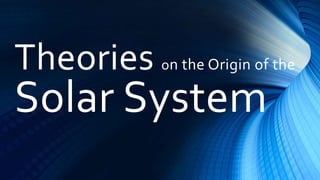
Theories on the origin of the Solar System
- 1. Theories on the Origin of the Solar System
- 2. What is the composition of our solar system?
- 3. Composition Of The Solar System •Star Planets •Natural satellites Comets •Asteroids Interplanetary medium •
- 4. Planets •Mercury Neptune •Venus Earth •Mars Jupiter •Saturn Uranus
- 5. Theories about the Origin of the Solar System
- 6. A Star System, also called “stellar system” is a small number of stars that orbit each other.
- 7. It should be noted that Earth belongs to the solar system, which is a type of star system because the sun is a star.
- 8. Nebular Hypothesis Immanuel Kant 1724- 1804 and Pierre-Simon Laplace 1749-1827
- 9. In the 1700s Emanuel Swedenborg, Immanuel Kant, and Pierre-Simon Laplace independently thought of a rotating gaseous cloud that cools and contracts in the middle to form the sun and the rest into a disc that become the planets.
- 10. He assumed that the mutual gravitational attractions of the particles caused them to start moving and colliding at which point chemical forces kept them bonded together. As some of these aggregates became larger, they grow more rapidly, ultimately forming the planets.
- 11. This nebular theory failed to account for the distribution of angular momentum in the solar system.
- 13. Encounter Hypotheses •Buffon’s (1749) Sun-comet encounter that sent matter to form planet; •James Jeans’ (1917) Sun-star encounter that would have drawn from the sun matter that would condense to planets,
- 14. T.C. Chamberlain and F. R. Moulton’s (1904) planetesimal hypothesis involving a star much bigger than the Sun passing by the Sun and draws gaseous filaments from both out which planetisimals were formed;
- 15. Accretion is the process of growth or increase, typically by the gradual accumulation of additional layers or matter. A planetesimal is an object formed from dust, rock, and other materials. A protoplanet is a large planetary embryo that originated within a protoplanetary disc. (planet in the making)
- 16. Ray Lyttleton’s (1940) sun’s companion star colliding with another to form a proto-planet that breaks up to form Jupiter and Saturn.
- 17. Otto Schmidt’s accretion theory proposed that the Sun passed through a dense interstellar cloud and emerged with a dusty, gaseous envelope that eventually became the planets. However, it cannot explain how the planets and satellites were formed. The time required to form the planets exceeds the age of the solar system.
- 18. M.M. Woolfson’s capture theory (Figure 4) is a variation of James Jeans’ near-collision hypothesis. In this scenario, the Sun drags from a near proto-star a filament of material which becomes the planets. Collisions between proto-planets close to the Sun produced the terrestrial planets; condensations in the filament produced the giant planets and their satellites. *Different ages for the Sun and planets is predicted by this theory.
- 19. Nobel Prize winner Harold Urey’s compositional studies on meteorites in the 1950s and other scientists’ work on these objects led to the conclusion that meteorite constituents have changed very little since the solar system’s early history and can give clues about their formation. The currently accepted theory on the origin of the solar system relies much on information from meteorites.
- 20. Protoplanet Hypothesis •About 4.6 billion years ago, in the Orion arm of the Milky Way galaxy, a slowly- rotating gas •and dust cloud dominated by hydrogen and helium starts to contract due to gravity
- 21. Take note that protoplanet theory incorporates many of the components of the nebular hypothesis but adds some new aspects from modern knowledge of fluids and states of matter.
- 22. As most of the mass move to the center to eventually become a proto-Sun, the remaining materials form a disc that will eventually become the planets and momentum is transferred outwards.
- 23. Due to collisions, fragments of dust and solid matter begin sticking to each other to form larger and larger bodies from meter to kilometer in size. These proto-planets are accretions of frozen water, ammonia, methane, silicon, aluminum, iron, and other metals in rock and mineral grains enveloped in hydrogen and helium.
- 24. High-speed collisions with large objects destroys much of the mantle of Mercury, puts Venus in retrograde rotation.
- 26. Collision of the Earth with large object produces the moon.This is supported by the composition of the moon very similar to the Earth's Mantle
- 27. When the proto-Sun is established as a star, its solar wind blasts hydrogen, helium, and volatiles from the inner planets to beyond Mars to form the gas giants leaving behind a system we know today.
- 29. Cosmic Journey Write a story of a fictional journey around the outerspace (science fiction) based on the terms and based on how you see the solar system.
- 30. Example: Alienation “Lets get out of here!” my neighbors yelled.What’s happening? Is China invading us?. . . . . . . . .